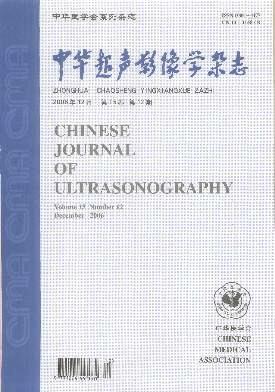Site-targeted imaging enhancement of viable myocardium after ischemia-reperfusion by a novel nano-scale ultrasound contrast agent: a vivo study
Q4 Medicine
引用次数: 0
Abstract
Objective To prepare a kind of lipid nanoparticle ultrasound contrast agents with the ability to target to viable myocardium for diagnosis. Methods The agent was a biotinylated, fluorescent-labelled, lipid-coated, liquid perfluorocarbon emulsion. Physico-chemical properties of the agent were measured, including size distribution, Zeta Potential, concentration and so on. Ischemia-reperfusion models were created in rats, and then exposed to biotinylated anti-MCP-1 monoclonal antibody, rhodamine avidin and biotinylated, FITC-labelled nanoparticles, respectively. Echocardiography was taken before and after injection. Frozen sections of their hearts were observed under fluorescence microscope. Results The particle diameter, zeta potential and concentration of lipid nanoparticles were (172.30±52.06)nm, (-33.10±6.50)mV and (2.28±0.46)×1011/ml, respectively. From the short-axis view, the myocardium under endocardium of anterior wall was enhanced obviously. While myocardium of other walls were still. The lipid nanoparticles located in the myocardium of anterior wall and gave out bright green and red fluorescence under fluorescence microscope, while neither lipid nanoparticles nor fluorescence were found in other sites of ventricular myocardium. Conclusions The viable myocardium can be targeted and acoustically enhanced by the self-made nano-scale ultrasound contrast agent. This new agent has potential to improve sensitivity and specificity for noninvasive identifying viable myocardium. Key words: Ultrasound contrast agents; Nano-scale; Perfluorocarbon; Viable myocardium一种新型纳米级超声造影剂对缺血再灌注后存活心肌的局部靶向成像增强:一项体内研究
目的制备一种能够靶向存活心肌进行诊断的脂质纳米粒子超声造影剂。方法采用生物素化、荧光标记、脂质包被的全氟化碳液体乳液。测定了该制剂的理化性质,包括大小分布、Zeta电位、浓度等。在大鼠体内建立缺血再灌注模型,然后分别暴露于生物素化的抗MCP-1单克隆抗体、罗丹明抗生物素和生物素化、FITC标记的纳米颗粒。在注射前后进行超声心动图检查。在荧光显微镜下观察他们的心脏冷冻切片。结果脂质纳米粒子的粒径、ζ电位和浓度分别为(172.30±52.06)nm、(-33.10±6.50)mV和(2.28±0.46)×1011/ml。短轴切面观察,前壁心内膜下心肌明显增强。其他壁心肌静止时。在荧光显微镜下,脂质纳米粒子位于前壁心肌,并发出明亮的绿色和红色荧光,而在心室心肌的其他部位没有发现脂质纳米粒子和荧光。结论自制的纳米级超声造影剂可对存活心肌进行靶向声学增强。这种新试剂有可能提高无创识别存活心肌的敏感性和特异性。关键词:超声造影剂;纳米尺度;全氟碳;存活心肌
本文章由计算机程序翻译,如有差异,请以英文原文为准。
求助全文
约1分钟内获得全文
求助全文
来源期刊

中华超声影像学杂志
Medicine-Radiology, Nuclear Medicine and Imaging
CiteScore
0.80
自引率
0.00%
发文量
9126
期刊介绍:
 求助内容:
求助内容: 应助结果提醒方式:
应助结果提醒方式:


